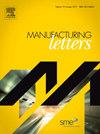Effects of wire feeding direction on the deposition characteristics of 316L stainless steel in laser-directed energy deposition
IF 1.9
Q3 ENGINEERING, MANUFACTURING
引用次数: 0
Abstract
This study investigates the effect of wire feeding direction on the microstructure of 316 stainless steel during the laser-directed energy deposition (L-DED) process. The process parameters were optimised by varying the scan speed, laser power, and wire feed rate to identify a common parameter set for all feed directions to give desired weld bead geometries. The identified process parameter window has shown that the conduction mode is preferred over the balling and keyhole modes. Comprehensive microstructural characterization using optical and electron microscopy has revealed that for the same parameters, the front wire feed had higher penetration, while the back wire feed had a wider bead with optimal penetration. The current findings are of significance for advancing wire-L-DED additive manufacturing for more complex component designs.

激光定向能沉积中送丝方向对316L不锈钢沉积特性的影响
研究了激光定向能沉积(L-DED)过程中送丝方向对316不锈钢显微组织的影响。通过改变扫描速度、激光功率和送丝速度来优化工艺参数,以确定所有送丝方向的通用参数集,从而获得所需的焊缝几何形状。所确定的工艺参数窗口表明,传导模式优于球化和锁孔模式。通过光学和电子显微镜的综合显微组织表征表明,在相同的参数下,前送丝具有更高的穿透力,而后送丝具有更宽的头并具有最佳的穿透力。目前的研究结果对于推进线- l - ded增材制造以实现更复杂的部件设计具有重要意义。
本文章由计算机程序翻译,如有差异,请以英文原文为准。
求助全文
约1分钟内获得全文
求助全文
来源期刊

Manufacturing Letters
Engineering-Industrial and Manufacturing Engineering
CiteScore
4.20
自引率
5.10%
发文量
192
审稿时长
60 days
 求助内容:
求助内容: 应助结果提醒方式:
应助结果提醒方式:


